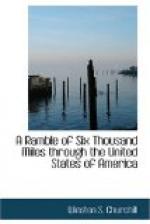A trapping expedition is being fitted out for the Rocky mountains, on an extensive scale. The number of persons intended to be employed on this, is about two hundred. Teams for the transportation of merchandize and luggage are preparing, which is an accommodation never enjoyed before by trappers, as pack-horses have always hitherto been substituted. These waggons may also be found useful as barricades, in case of an attack from the Indians. The expedition will be absent two or three years.
A trade with Santa Fe is also established. In the Spanish country the traders receive, in exchange for dry goods and merchandize of every description, specie, principally; which makes money much more plentiful here than in any other town in the western country.
The caravans generally strike away, near the head waters of the Arkansas and Red rivers, to the south-west, close to the foot of the Rocky mountains—travelling above a thousand miles through the Indian country before they reach the Mexican boundary. These journeys are long and tedious, and require men of nerve and muscle to undertake them; the morasses and rivers which they have to cross—the extensive prairies and savannahs they have to traverse, and the dense forests to penetrate, are sufficient to subdue any but iron constitutions.
The countries west of the Mississippi are likely to be greatly enriched by the trade with Mexico; as, in addition to the vast quantities of valuable merchandize procured from that country, specie to a very large amount is put in circulation, which to a new country is of incalculable advantage. The party which lately returned to Fayette in Missouri, brought 200,000 dollars in specie.
The lead-mines of Galena and Potosi inundate St. Louis with that metal. The latter mines are extensive, consisting of forty in number, and are situated near the head of Big-river, which flows into the Merrimac: a water transportation is thus effected to the Mississippi, eighteen miles below St. Louis. This, however, is only in the spring and fall, as at other seasons the Merrimac is not navigable for common-sized boats, at a greater distance than fifty miles from its mouth. The Merrimac is upwards of 200 miles in length, and at its outlet it is about 200 yards in breadth.
The principal buildings in St. Louis are, the government-house, the theatre, the bank of the United States, and three or four Catholic and Protestant churches. The Catholic is the prevalent religion. There are two newspapers published here. Cafes, billiard tables, dancing houses, &c., are in abundance.
The inhabitants of St. Louis more resemble Europeans in their manners and habits than any other people I met with in the west. The more wealthy people generally spend some time in New Orleans every year, which makes them much more sociable, and much less brusque than their neighbours.
We visited Florissant, a French village, containing a convent and a young ladies’ seminary. The country about this place pleased us much. We passed many fine farms—through open woodlands, which have much the appearance of domains—and across large tracts of sumach, the leaves of which at this season are no longer green, but have assumed a rich crimson hue. The Indians use these leaves as provision for the pipe.




